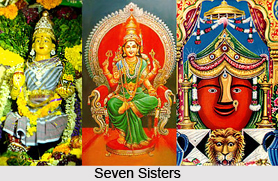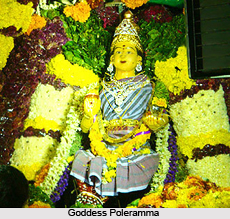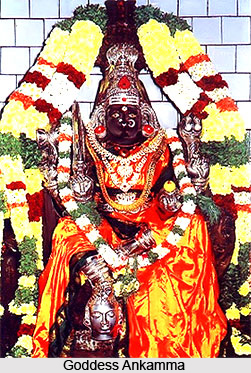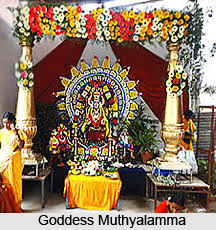 Some of the Dravidian Deities like Goddess Ankamma, Goddess Verdatchamma, Goddess Renuka, Kanaka Durgamma, Goddess Dilli Polasi, Goddess Poleramma, Goddess Kulagollamma, Goddess Mathamma, Goddess Muthyalamma, Seven Sisters, Goddess Bandlamma, Goddess Poshamma, Goddess Bangaramma and many others are revered with honour.
Some of the Dravidian Deities like Goddess Ankamma, Goddess Verdatchamma, Goddess Renuka, Kanaka Durgamma, Goddess Dilli Polasi, Goddess Poleramma, Goddess Kulagollamma, Goddess Mathamma, Goddess Muthyalamma, Seven Sisters, Goddess Bandlamma, Goddess Poshamma, Goddess Bangaramma and many others are revered with honour.
Goddess Bangaramma
Goddess Bangaramma has no temple of her own but her image is placed in the temple of Goddess Poleramma. At times it is also seen that she has a smaller temple near that of Poleramma and receives a small share of the worship. Bangaramma`s worship is common to that of Poleramma. It begins mildly. It is apprehended that there may be some connection between the name Bangaramma, meaning ` the golden one `, and mild nature.
 Goddess Poshamma
Goddess Poshamma
Goddess Poshamma is a folk deity who is worshiped by offering rituals. A sacrifice is offered by some of the villagers. A small procession takes place where several people participate that is led by a Madiga beating a drum. Thereafter came two men of the washer man caste, each carrying a lamb. Then the women came each with a brass utensil or drinking cup and with baskets containing food and other offerings. The entire group of people marched three times around the green tree under which the idols stood and then halted in front of them. The lambs are placed on the ground in front of the idols. The two women splash some water over the idols and then worship them. Then yellow, red and purple powders are put on the idol. After this each woman placed a small leaf plate of rice before each image, poured ghee and curds over the food and light incense sticks. Then the idols are worshipped again.
Goddess Bandlamma
Goddess Bandlamma is considered to be the goddess of carts. The word "bandlu means carts. According to a legend she was originally a goddess in the village of Chandaluru, Nellore District. However one day she followed some carts which were going on the road to Madras. They camped at the village of Ravuru near Ramapatnam at night. She appeared in a dream to one of the cart men who was a native of that place and told him that she desired to change her residence and would protect them if they built a temple and worshipped her.
Goddess Muthyalamma
Muthyalamma is worshipped in Ashada month during Maha kali festival in Telangana district. Every weekend big celebrations take place in Bollarum and Secunderabad in Andhra Pradesh. The worship of goddess Muthyalamma is same as that of Goddess Poleramma. In the yatra for Muthyalamma a temporary clay image is used to represent the goddess. This is afterwards left to be crushed underfoot. At this time the goddess is worshipped in order to bring rain.
 Goddess Mathamma
Goddess Mathamma
Goddess Mathamma is worshipped by the Madigas community. All other castes fear her and contribute to her worship. However Madigas are very poor thus her worship is less elaborate as compared to other goddesses. She is represented by a small stone image in a small shrine. A buffalo is arranged for the jatara and turned loose until the appointed day. The image is bathed and a sheep is offered. The buffalo sacrifice is performed as usual along with ceremonies already described. On the last day the Madiga pujari cuts off its head before the idol and holding it by the legs, brushes away the muggu before the idol. This removes the last traces of the evil which may come from Mathamma.
Goddess Renuka
The origin of Goddess Renuka is connected with the origins of all the other goddesses. In case of Goddess Renuka the worship and ceremonies are the same as that of other Goddesses. Goddess Renuka is also known as Yellamma who is worshiped as the Goddess of the fallen in the Hindu pantheon. Yellamma is a goddess of rural folk of Karnataka and Andhra Pradesh. According to legends Yellamma is the incarnation of Kali who symbolizes the death of ego as well as the mother who is concerned about her children.
Goddess Poleramma
Goddess Poleramma is worshiped as a village God who is worshipped in order to protect the village. The shrine is kept outside the village and quite frequently on the bank of an irrigation tank. The shrine is very crude at times built with stones and mud. Goddess Poleramma hardly has a temple built after the pattern of those Lord Shiva temples which are found in the villages. Poleramma is considered as the goddess of smallpox in Andhra Pradesh. She is considered responsible for all other troubles in the village like cattle disease, drought, and sickness among the people. A bloody sacrifice is offered to appease the goddess. Some cactus leaves are placed on the wall near the gate. Sometimes it is placed over the door. Poleramma, seeing the cactus, will think the place uninhabited and pass on as cactus would not be allowed to grow on the wall of an occupied house. Thereafter a sheep or small buffalo is tied to the leg of the cot on which the sick man is dying. The animal is an offering. It is hoped that with this Poleramma will be satisfied and leave the house.
 Kanaka Durgamma
Kanaka Durgamma
Kanaka Durgamma is responsible for cattle welfare and is appeased when there is cattle disease. At times she is also worshipped when there is any sickness among the people. There is a customary method to worship Kanaka Durgamma. Some woman become possessed Kanaka Durgamma`s spirit and running to water will throw herself in. The people rescue her. Thereafter she runs to a margosa tree and break off twigs will put them in her mouth as if she was a mad woman. The people ask the woman about her identity as they wish to know what spirit has taken possession of her. Thereafter the people enquire about her demands. She puts her demand before the people and they are obeyed too. The carpenter of the village makes a wooden image from a branch of a margosa tree. When the branch is cut off it should not be allowed to touch the ground else it would be tainted. The image looks rude. It is around two feet tall and represents a woman with a sword in her hand. The work should commence in the evening and should be completed before dawn. When the image is made it should be placed before water and kept there until the ceremonies are over. Meanwhile the Madigas make a booth in grove outside the village. This booth answers for the temple which the Goddess demands. Next day in the morning the village washer man takes the image from the water and carefully adorning it with jewels.
Goddess Verdatchamma
The story of Goddess Verdatchamma contains the unusual trait of human sacrifice. When she lived on earth she and her husband did not reside together as she was born of the gods. This is a fact that is established in history. The fact that she did not dwell with her husband indicates an unusual condition in the society. There is a possibility that she was called Shakti because of her attitude.
Verdatchamma gave money to construct the great tank which lies between two high hills. There were two diggers. Every day they dug and every night the bank broke apart. The legend says that these two men were brothers who had discussed the matter and was quarrelling over it. While they were discussing, a voice came from the ground in the tank. Two shepherd boys named Pedda Kambudu and Chinna Kambudu heard this. They reported it to Verdatchamma and offered to be the sacrifices themselves. Their request was that their memory should be in some way maintained. The boys were killed and in their names two pipes were placed in the bank of the tank for discharge of water. The tank was thereafter completed without trouble.
Origin of Dravidian lies in the local stories which are of the greatest importance. These are the only sources from which one can secure any-light on the history and development of the worship as well as the fundamental reasons for the development of the system. The legends of the Seven Sisters are similar to those relating to the other Dravidian gods of India. The stories are also linked to the Hindu legends.









